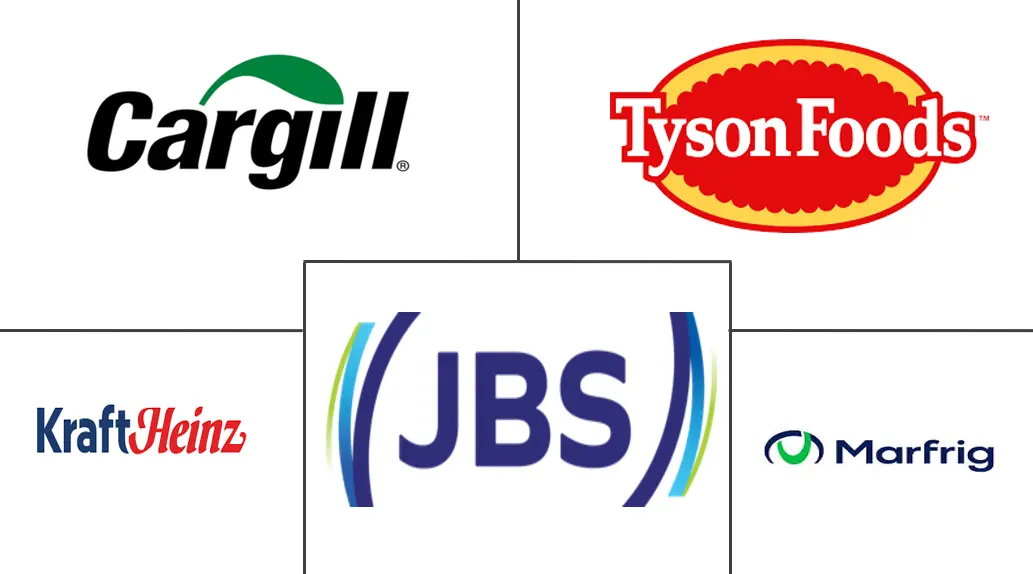Processed Beef Market Size and Share
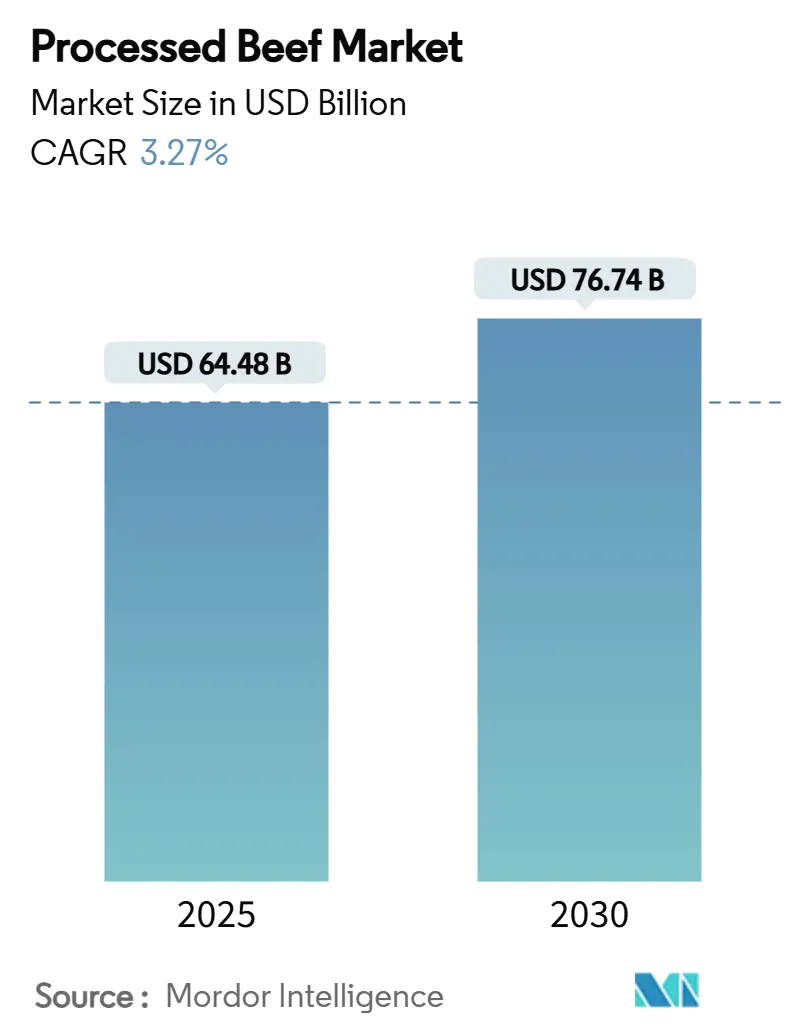
Processed Beef Market Analysis by Mordor Intelligence
The processed beef market size reached USD 64.48 billion in 2025 and is projected to expand to USD 76.74 billion by 2030, registering a 3.27% CAGR over the forecast period. Demand for convenience proteins, investments in automation, and rising sustainability standards underpin the market’s forward momentum. Premiumization in snack formats, the rapid rollout of case-ready lines, and carbon-credit incentives for verified low-methane beef widen profit pools even as plant-based rivals intensify competition. Technology spending on robotic deboning and packaging automation highlights a shift from labor-intensive workflows toward digitally enabled plants. Meanwhile, e-commerce penetration for fresh protein reshapes last-mile logistics, forcing processors to master cold-chain orchestration and just-in-time replenishment.
Key Report Takeaways
- By product category, ground beef led with a 38.48% processed beef market share in 2024, while beef snacks are forecast to grow at a 4.57% CAGR through 2030.
- By processing method, fresh-chilled processing held 43.86% of the processed beef market size in 2024; ready-to-eat/ready-to-heat formats are advancing at a 4.15% CAGR.
- By distribution channel, supermarkets and hypermarkets maintained 52.90% revenue share in 2024; online retailers are projected to post the fastest growth at a 6.83% CAGR to 2030.
- By breed type, Angus beef commanded 36.27% of demand in 2024, while Wagyu is projected to expand at a 5.29% CAGR through 2030.
- By region, North America accounted for 39.48% of global revenues in 2024; Asia-Pacific is the fastest-growing region with a 3.81% CAGR to 2030.
Global Processed Beef Market Trends and Insights
Driver Impact Analysis
| Driver | (~) % Impact on CAGR Forecast | Geographic Relevance | Impact Timeline |
|---|---|---|---|
| Robust demand for ground beef in retail & food-service | +0.8% | North America & Europe | Medium term (2-4 years) |
| Expansion of case-ready and vacuum-skin packaging lines | +0.6% | Global, with concentration in developed markets | Short term (≤ 2 years) |
| Carbon-credit premiums for verified low-methane beef | +0.4% | Australia, Argentina, North America | Long term (≥ 4 years) |
| Roll-out of AI-enabled robotic deboning boosting yield | +0.5% | North America, Europe, Asia-Pacific | Medium term (2-4 years) |
| Emerging middle-class consumption in ASEAN & Africa | +0.7% | ASEAN core, Sub-Saharan Africa | Long term (≥ 4 years) |
| Surge in e-commerce grocery penetration for fresh proteins | +0.3% | Global, led by Asia-Pacific and North America | Short term (≤ 2 years) |
| Source: Mordor Intelligence | |||
Robust Demand for Ground Beef in Retail & Food Service
Ground beef's versatility, from QSR burgers to home-style tacos, keeps it in demand. Even as cattle inventories are projected to dip to 27.9 million head in 2025[1]NACS, "Beef Prices Hit Record High", 2025, www.convenience.org, marking the lowest count since 1952, retailers like Walmart are taking steps to secure their supply chains. By opening proprietary meat-packing sites, they're employing a vertical-integration strategy that benefits those with larger procurement scales. Meat Processors are not only optimizing yields but also renegotiating long-term contracts. In the processed beef market, ground beef stands out as both a volume anchor and a price benchmark, influencing raw-material risk management strategies throughout the value chain. Ground beef's affordability and versatility make it a staple in dishes like burgers and tacos, it is further bolstered by the swift growth of fast food chains and shifting dietary preferences. Younger consumers, in particular, are gravitating towards protein-rich, animal-based products, whether in retail or dining out. There's also a notable surge in interest for premium options, including natural and grass-fed ground beef. Catering to consumers across all economic classes and aligning with trends emphasizing convenience and value, ground beef remains a staple on retail shelves and a favorite in diverse food-service offerings.
Expansion of Case-Ready and Vacuum-Skin Packaging Lines
Vacuum-skin packaging (VSP) outperforms traditional formats in color stability and bacterial control, leading to longer shelf life and reduced retail shrinkage. Academic studies indicate that VSP-treated beef maintains its consumer-desired redness for an extended period, with microbial counts staying below critical thresholds for additional days. Cargill's strategic acquisition of two Ahold Delhaize processing plants in 2025, aimed at expanding case-ready offerings, underscores a board-level belief in the potential of packaging innovations to command premium market positions and realize labor efficiencies. Processors who retrofit their lines for VSP stand to benefit from higher-margin SKUs, bolstering the processed beef segment. The rise of case-ready and vacuum-skin packaging lines is reshaping the global processed beef landscape, catering to heightened consumer demands for freshness, safety, and convenience. Advanced formats like vacuum-skin and case-ready packs not only prolong shelf life and reduce food waste but also bolster food safety by acting as robust barriers against oxygen and microbes. These innovations align with the evolving retail push for products that are ready for display. Furthermore, they optimize logistics by minimizing handling and spoilage risks, catering to the demand for portion-controlled, traceable, and visually appealing meat, especially in North America's and Europe's developed markets. With major retailers and processors channeling investments into automation, recyclable materials, and intelligent packaging solutions, the momentum behind these innovations is poised to surge, enhancing the global accessibility, quality, and retail value of processed beef.
Carbon-Credit Premiums for Verified Low-Methane Beef
Beef producers are tapping into new revenue streams, driven by sustainability credentials. Argentina's carbon-neutral beef certification and Australia's CN30 initiative highlight the market's appetite for verified low-emission beef. JBS Foods is making a significant push[2]Meat and livestock Australia, "Environmental sustainability", www.mla.com.au, pouring USD 1 billion into beef facility upgrades and another USD 100 million into R&D by 2030. Notably, they've allocated USD 150,000 to the Soil and Water Outcomes Fund, aiming to boost carbon sequestration in beef production. These strategic moves position these early adopters to command premium prices, as both consumers and institutional buyers increasingly favor environmental credentials in their beef choices. The global processed beef market is witnessing a transformation, with carbon-credit premiums for verified low-methane beef emerging as a significant driver. It offers producers a financial nudge to reduce emissions and set their products apart. As global methane-reduction initiatives, like the Global Methane Pledge, gain traction, beef producers are seizing the moment. This evolving landscape is channeling investments into climate-conscious beef supply chains. Moreover, it's enabling processors and exporters to tap into new revenue streams, leveraging both voluntary and regulated carbon markets that reward genuine emission reductions.
Roll-Out of AI-Enabled Robotic Deboning Boosting Yield
AI-enabled robotic deboning systems are revolutionizing the global processed beef market. By harnessing advanced 3D vision, force-sensing, and machine learning, these systems enhance cutting and deboning operations. These intelligent robots adapt to the unique anatomical structures of each carcass, ensuring precise meat removal, minimal waste, and consistent portioning—even in conditions that challenge traditional methods. With real-time data analysis and adaptive learning, AI-driven robots boost yield and efficiency, reduce reliance on skilled labor, and lessen the risk of repetitive strain injuries for workers. As adoption speeds up, commercial solutions showcase significant productivity boosts. New systems outpace older electromechanical setups in both throughput and precision. They also empower plants, regardless of size, to provide tailored cuts for varied market needs. This tech-driven shift not only enhances profitability for processors but also tackles labor shortages, setting elevated benchmarks for quality and consistency in global processed beef production.
Restraint Impact Analysis
| Restraint | (~) % Impact on CAGR Forecast | Geographic Relevance | Impact Timeline |
|---|---|---|---|
| Increasing Competition from Plant-Based and Hybrid Alternatives | -0.4% | Global, concentrated in developed markets | Medium term (2-4 years) |
| Intensifying regulatory scrutiny on processed-meat health claims | -0.3% | North America, Europe | Short term (≤ 2 years) |
| Rise of plant-based and cultivated protein substitutes | -0.2% | North America, Europe, Asia-Pacific | Long term (≥ 4 years) |
| Retailer margin squeeze causing private-label price wars | -0.5% | Global retail markets | Short term (≤ 2 years) |
| Source: Mordor Intelligence | |||
Increasing Competition from Plant-Based and Hybrid Alternatives
Innovations in plant protein extraction, fermentation, and food technology are enabling manufacturers to craft meat substitutes that closely replicate the taste, texture, and nutritional profile of traditional beef products. This surge in competition from plant-based and hybrid alternatives is becoming a notable challenge for the global processed beef market. Heightened consumer awareness regarding health, animal welfare, and environmental issues—particularly deforestation and greenhouse gas emissions—has spurred a growing demand for these alternatives. Supermarkets, foodservice chains, and major food conglomerates are swiftly broadening their plant-based and hybrid product lines, escalating the competition for both retail shelf space and menu visibility. Consequently, traditional processed beef is under increasing strain, especially from health-conscious, flexitarian, and environmentally-conscious consumers. These consumers are drawn to the ethical and sustainable appeal of meat substitutes, which could hinder the growth and market share of conventional beef products. Also, market players such as Beyond Meat is directly targeting meat eaters through high-protein analogues, pressuring processors to differentiate on provenance, welfare, and lower environmental impact rather than price alone. A tighter focus on messaging and innovation is therefore critical to sustain processed beef market volumes.
Retailer Margin Squeeze Causing Private-Label Price Wars
As inflationary pressures and cost volatility mount, retailers are increasingly turning to aggressive promotions of their private-label brands. This shift, driven by a desire to attract value-conscious consumers, intensifies the ongoing price wars. Private label brands only held a minimal share in the market, as there is an increased preference for established national brands, which is associated with quality assurance. Yet, with rising input costs and operational expenses, retailers find themselves in fierce competition. They're not only slashing prices but also broadening their private-label assortments. This strategy aims to defend their market share and maintain foot traffic, particularly in online and mass retail channels. Such price-driven tactics are compressing margins throughout the supply chain. As a result, both private-label and branded suppliers are reevaluating their product and promotional strategies. This "race to the bottom" not only risks diminishing investments in product innovation and sustainability but also threatens the overall profitability of manufacturers and retailers. Furthermore, it poses a challenge for national brands, pushing them to find meaningful differentiation beyond just price.
Segment Analysis
By Processing Method: Fresh-Chilled Dominates as Ready-to-Heat Gains Pace
Fresh-chilled beef dominates the global processed beef market, commanding a 43.86% share. This preference stems from consumers' desire for minimally processed, high-quality meat that retains its flavor and texture. Developed markets in North America, Europe, and parts of Asia, especially in premium retail and foodservice sectors, favor fresh-chilled beef, where quality is paramount. Innovations in cold chain logistics and packaging technologies, like modified atmosphere packaging (MAP) and case-ready solutions, have enhanced their shelf life without sacrificing integrity. Health-conscious consumers increasingly prefer chilled beef over frozen or canned options, linking it to freshness, purity, and fewer additives. This preference solidifies its presence in supermarkets, butcher shops, and upscale restaurants worldwide.
On the other hand, the Ready-to-Eat (RTE) and Ready-to-Heat (RTH) segment, registering a CAGR of 4.15% is the fastest-growing processing method. This surge is driven by a consumer shift towards convenient, time-saving, protein-rich meals that cater to today's fast-paced lifestyles. Factors like urbanization, the rise of dual-income households, and a growing affinity for Western diets—particularly in emerging markets—are propelling the demand for value-added processed beef. Offerings like cooked meatballs, microwavable meals, and shelf-stable snacks are gaining traction. In response, foodservice operators and ready-meal brands are broadening their menus to align with consumer desires for quick, high-quality, portion-controlled proteins. With ongoing innovations in shelf life, packaging, and clean-label formulations, the RTE/RTH segment is poised for sustained double-digit growth, altering global processed beef consumption trends.
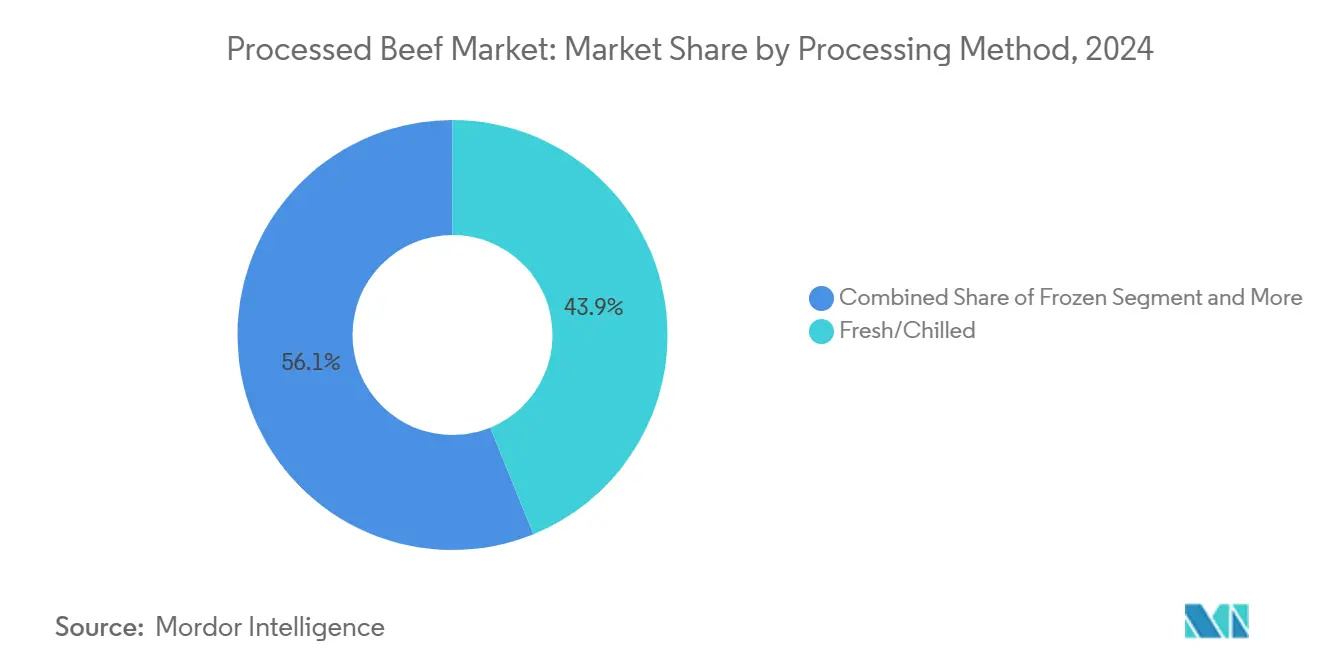
Note: Segment shares of all individual segments available upon report purchase
By Distribution Channel: Supermarkets Hold the Lead While Online Surges
In 2024, supermarkets and hypermarkets captured 52.90% of global revenues, leveraging the allure of one-stop shopping and robust private-label programs to foster shopper loyalty. Weekly circulars and loyalty apps drive consistent sales, while in-store butchers serve as quality assurance. Large-scale buyers negotiate advantageous terms with packers, guaranteeing a steady supply of case-ready products, even amidst supply disruptions. These strategic moves solidify supermarkets' dominance in the processed beef market, even as competition intensifies for consumers' protein dollars.
On the other hand, online grocery shopping is emerging as the fastest-growing outlet, boasting a 6.83% CAGR. This surge is fueled by innovations like same-day delivery, insulated totes, and AI-driven route optimization. The COVID-19 pandemic acted as a catalyst, prompting many to trial this channel, and the trend has stuck, especially among digital natives who value the click-to-cart ease. Walmart's strategic decision to inaugurate its inaugural beef-processing plant underscores its intent to gain upstream control over supplies, particularly those earmarked for e-commerce. Furthermore, subscription-based steak boxes and algorithmically curated protein bundles not only enhance customer engagement but also yield invaluable zero-party data. With a notable decline in cold-chain failures, online platforms are poised to expand their foothold in the processed beef market.
By Breed Type: Angus Commands Scale While Wagyu Drives Premium Growth
Angus beef dominates the global processed beef market, commanding a 36.27% share. This supremacy stems from Angus's reputation as a premium-quality beef, celebrated for its marbling, tenderness, and consistent flavor. Retailers and foodservice operators in North America, Europe, and Australia actively promote Angus-branded products, like Certified Angus Beef, capitalizing on consumer trust and their readiness to pay a premium. Angus beef's versatility shines in processed forms, including ground beef, burger patties, sausages, and deli meats, making it a favorite in both fresh-chilled and fast-casual dining. Its genetic advantages, efficient feed conversion, and climate adaptability further cement Angus's status as the go-to breed for large-scale beef production.
Wagyu beef has emerged to be the fastest-growing breed segment, registering a CAGR of 5.29%. The surging appetite for ultra-premium dining experiences has catapulted Wagyu from a luxury niche to a burgeoning presence in high-end retail and gourmet products. Renowned for its marbling and flavor, Wagyu is now a staple in value-added formats like burgers, beef jerky, ready-to-cook meals, and premium cuts. With heightened interest from the U.S., China, South Korea, and the Middle East, both purebred and crossbred Wagyu production is on the rise. This surge enables processors to offer luxury-quality beef at more palatable prices. As consumers refine their tastes, Wagyu's elite status is driving significant growth in the premium processed beef segment.
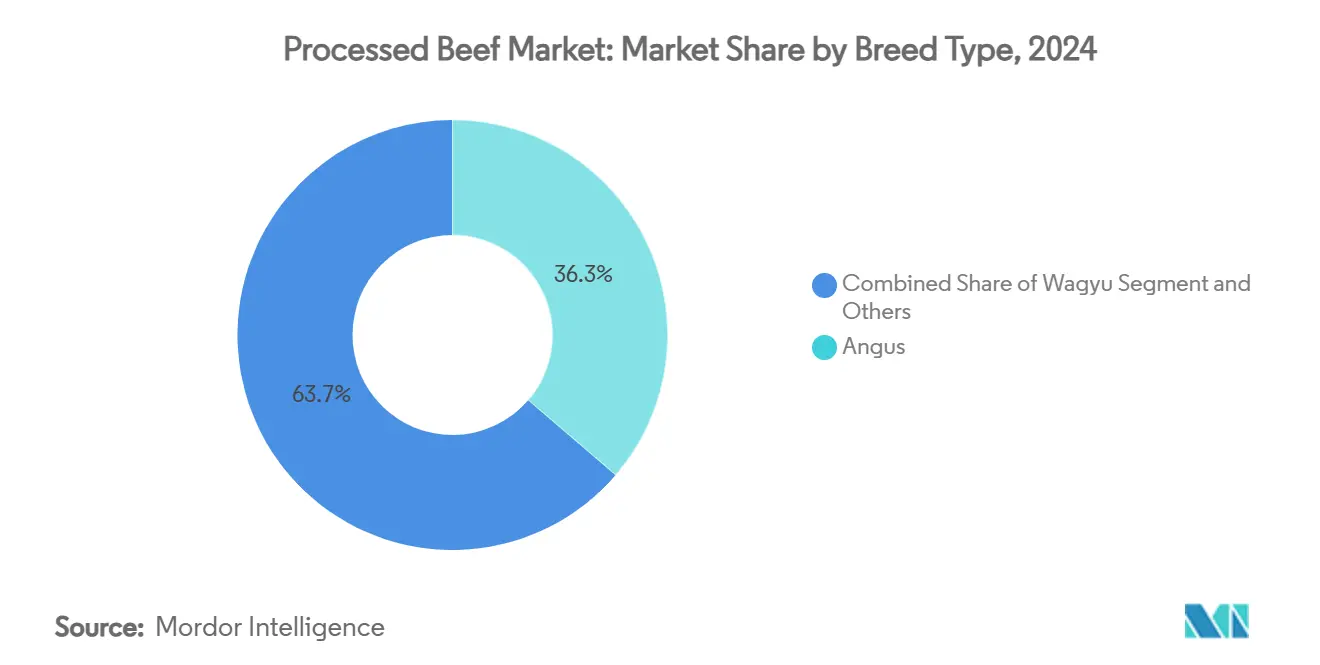
Note: Segment shares of all individual segments available upon report purchase
By Product Type: Ground Beef Dominance Meets Snack Innovation
In 2024, ground beef dominated the processed beef market, accounting for 38.48% of total revenues. Its widespread appeal can be attributed to its essential role in staples like burgers, tacos, and meat sauces, which are mainstays in retail shopping carts and quick-service restaurant (QSR) menus. It is bolstered by a rising appetite for convenient, protein-rich diets, a growing preference for premium and natural options, and the ongoing expansion of branded beef programs. To fortify their supply chains, major packers have expanded their proprietary grinding rooms. At the same time, supermarkets have embraced case-ready chubs, streamlining operations by cutting back-room labor and minimizing shrinkage. These tactics, combined with relentless promotional efforts, have cemented ground beef's status as the volume workhorse, helping to stabilize the overall processed beef market amidst economic fluctuations.
Beef snacks, though still a niche, are expanding rapidly at a 4.57% CAGR through 2030, driven by protein-seeking consumers gravitating towards portable formats. The FSIS mandates multi-hurdle pathogen controls for ready-to-eat fermented and dried items, a challenge that benefits larger operators with HACCP expertise. In response, brands are introducing single-serve jerky and biltong pouches, proudly featuring zero added nitrates and grass-fed sourcing, commanding retail prices significantly higher than standard commodity cuts. Retailers prominently display meat snacks at checkout lanes and in fitness aisles, while e-commerce subscription boxes enhance direct-to-consumer outreach. Flavor innovations, ranging from gochujang to maple-chipotle, are expanding the appeal of beef snacks beyond traditional jerky enthusiasts, ensuring this sub-category continues to elevate the premium segment of the processed beef market.
Geography Analysis
In 2024, North America commanded a dominant 39.48% share of global revenues, bolstered by its integrated feedlots, packing plants, and expansive retail networks. As labor shortages tighten, especially in the historically low-unemployment Midwestern hubs, the rollout of robotics gains significant traction. Concurrently, carbon-credit initiatives in various US states align with corporate net-zero ambitions, nudging ranchers towards adopting feed additives and rotational grazing methods to mitigate methane emissions. Heightened regulatory scrutiny sees the FSIS ramping up random Salmonella sampling, urging processors to bolster their sanitary-design audits. Meanwhile, ongoing consolidation among mid-tier packers underscores a regional strategy to uphold scale advantages and solidify their dominance in the processed beef market.
Asia-Pacific leads with a robust 3.81% CAGR, driven by an urbanizing middle class's insatiable appetite for diverse protein sources. In the ASEAN region, bolstered cold-chain capacities have significantly reduced last-mile spoilage, allowing retailers to offer chilled beef cuts that were once deemed a luxury[3]Choices Magazine Editors, “ASEAN Poultry Production Trends,” choicesmagazine.org. Governments are channeling investments into rail-linked logistics parks, effectively slashing inland freight times that previously hampered distribution. Australia, capitalizing on pasture-based efficiencies has secured premium import positions in Japan, South Korea, and, with expanding quotas, an increasingly receptive China. Meanwhile, Indian e-commerce pioneers are navigating halal-certified beef exports to Gulf nations, utilizing Singapore as a trans-shipment hub, underscoring the burgeoning trade dynamics fueling the processed beef market's growth.
Europe, while mature, distinguishes itself with Protected Geographical Indication (PGI) schemes and stringent animal-welfare standards, enhancing market transparency. Supermarkets are experimenting with carbon-footprint labels on steak packages, prompting processors to disclose comprehensive emission data from production to shelf. Eastern Europe, with the backing of EU-funded initiatives, is refining feedlot genetics, leading to improved carcass weights and marbling. In South America, packers from Brazil and Argentina are reaping benefits from favorable feed economics and supportive monetary policies. However, mounting deforestation concerns have led foreign buyers to insist on satellite-verified sourcing. In the Middle East and Africa, there's a growing embrace of cold-chain public-private partnerships. Countries like Nigeria and Kenya are rolling out fiscal incentives for local processing plants, aiming to reduce their dependence on frozen imports. These diverse regional developments collectively strengthen the global framework of the processed beef market.
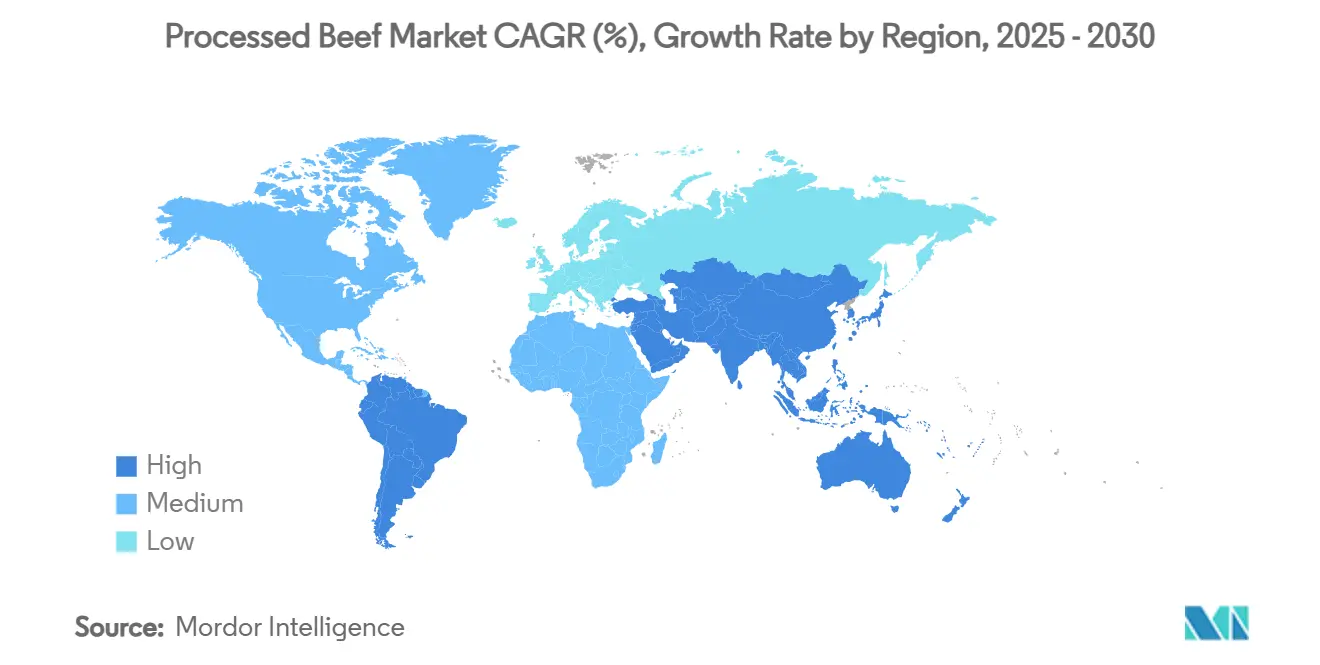
Competitive Landscape
Dominant players like JBS, Tyson Foods, and Cargill lead the global processed beef industry, which sits at a moderate concentration level of 5 out of 10. These giants harness their scale advantages throughout the beef supply chain, from procurement and processing to worldwide distribution. Operating under vertically integrated models, they maintain control over sourcing, achieve cost efficiencies, and ensure supply continuity—vital in a market characterized by tight margins and fluctuating commodity prices. Yet, despite their resilience, these industry stalwarts grapple with intensifying competition from premium beef brands and the surging plant-based alternatives. These challengers are riding the wave of evolving consumer preferences, emphasizing sustainability, health, and product traceability.
In a bid to stay ahead, leading beef processors are channeling significant investments into technological innovations and automation. A notable trend is the embrace of robotic deboning systems and AI-driven processing tools. These advancements not only optimize meat yield and bolster food safety but also lessen dependence on manual labor. Furthermore, cutting-edge packaging solutions, like vacuum-skin systems and modified atmosphere packaging (MAP), are gaining traction. These technologies play a pivotal role in extending shelf life and maintaining product integrity—crucial factors in a fiercely competitive retail landscape. Companies with the financial muscle to invest in extensive automation and facility upgrades are carving out long-term advantages, especially in light of rising labor costs and heightened regulatory scrutiny on food processing standards.
Beyond operational enhancements, lucrative opportunities are surfacing in premium and value-added beef segments. Here, attributes like sustainability, breed authenticity, and specialized processing can command higher margins. The burgeoning patent activity in vacuum packaging underscores the industry's commitment to prolonging product freshness and enhancing consumer convenience. Meanwhile, new entrants and direct-to-consumer beef brands, often championing sustainable and traceable production, are upending traditional distribution norms. They're doing so by harnessing the power of e-commerce and savvy digital branding. In a strategic counter, established players are leaning into acquisition-driven growth and fostering internal innovations. A case in point is Maple Leaf Foods’ business realignment in March 2025, emblematic of a wider industry pivot towards concentrated, brand-centric growth and specialized operations. Such maneuvers hint at a potential acceleration in consolidation trends within the processed beef value chain.
Processed Beef Industry Leaders
-
JBS S.A.
-
Tyson Foods Inc.
-
Marfrig Global Foods
-
Cargill, Incorporated
-
The Kraft Heinz Company
- *Disclaimer: Major Players sorted in no particular order
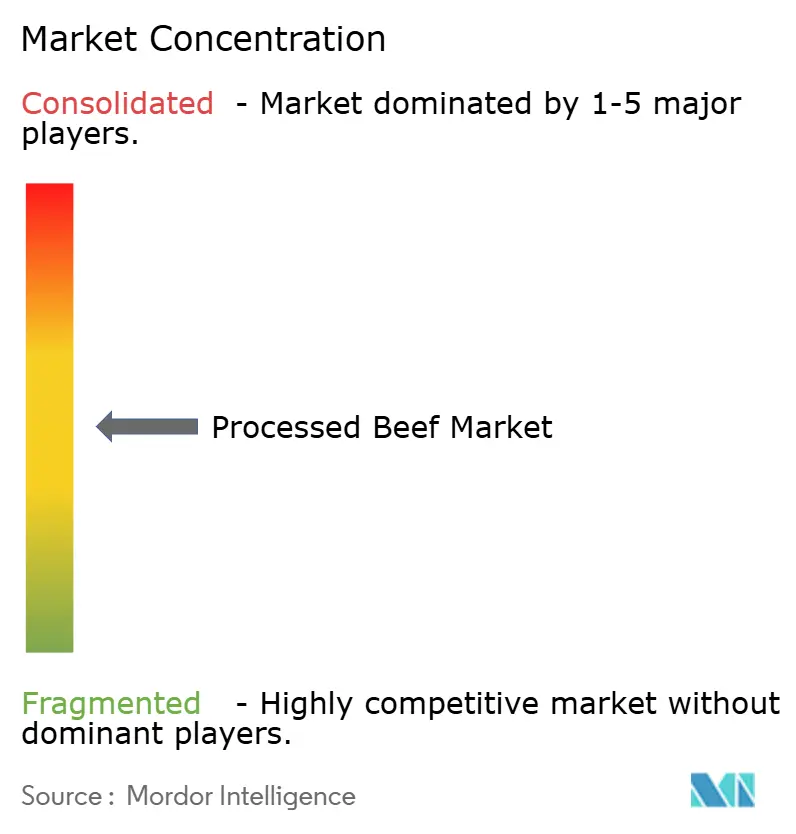
Recent Industry Developments
- June 2025: Tyson Foods launched Wright Brand Premium Sausage Links featuring beef-based varieties with 12-13 grams protein per serving, targeting growing consumer demand for premium, protein-rich beef products with nationwide rollout .
- February 2025: JBS, the Brazilian meat processing behemoth, unveiled a USD 200 million investment plan targeting its facilities in Cactus, Texas, and Greeley, Colorado. The primary goals of these investments are to enhance plant efficiency and potentially ramp up production. Furthermore, the initiative seeks to provide advantages to cattle producers, consumers, JBS's workforce, and the surrounding rural communities.
- February 2024: Cargill purchased two meat processing facilities from Ahold Delhaize USA to enhance production and distribution of case-ready beef products, expanding beef processing capabilities in Northeast U.S. while continuing to service Ahold Delhaize brands
Global Processed Beef Market Report Scope
| Ground Beef |
| Cooked/Smoked Beef |
| Cured and Shelf-stable |
| Frozen Beef Specialties |
| Beef Snacks |
| Fresh-chilled |
| Frozen |
| Canned/Aseptic |
| Ready-to-Eat/Ready-to-Heat |
| On-trade | |
| Off-trade | Supermarkets/Hypermarkets |
| Specialty Stores | |
| Online Retailers | |
| Others |
| Angus |
| Wagyu |
| Hereford |
| Chalorais |
| Others |
| North America | United States |
| Canada | |
| Mexico | |
| Rest of North America | |
| Europe | Germany |
| United Kingdom | |
| Italy | |
| France | |
| Spain | |
| Netherlands | |
| Russia | |
| Belgium | |
| Sweden | |
| Rest of Europe | |
| Asia-Pacific | China |
| India | |
| Japan | |
| Australia | |
| Indonesia | |
| South Korea | |
| Thailand | |
| Singapore | |
| Rest of Asia-Pacific | |
| South America | Brazil |
| Argentina | |
| Chile | |
| Peru | |
| Rest of South America | |
| Middle East and Africa | South Africa |
| Saudi Arabia | |
| United Arab Emirates | |
| Nigeria | |
| Egypt | |
| Iran | |
| Turkey | |
| Rest of Middle East and Africa |
| By Product Type | Ground Beef | |
| Cooked/Smoked Beef | ||
| Cured and Shelf-stable | ||
| Frozen Beef Specialties | ||
| Beef Snacks | ||
| By Processing Method | Fresh-chilled | |
| Frozen | ||
| Canned/Aseptic | ||
| Ready-to-Eat/Ready-to-Heat | ||
| By Distribution Channel | On-trade | |
| Off-trade | Supermarkets/Hypermarkets | |
| Specialty Stores | ||
| Online Retailers | ||
| Others | ||
| By Breed Type | Angus | |
| Wagyu | ||
| Hereford | ||
| Chalorais | ||
| Others | ||
| Geography | North America | United States |
| Canada | ||
| Mexico | ||
| Rest of North America | ||
| Europe | Germany | |
| United Kingdom | ||
| Italy | ||
| France | ||
| Spain | ||
| Netherlands | ||
| Russia | ||
| Belgium | ||
| Sweden | ||
| Rest of Europe | ||
| Asia-Pacific | China | |
| India | ||
| Japan | ||
| Australia | ||
| Indonesia | ||
| South Korea | ||
| Thailand | ||
| Singapore | ||
| Rest of Asia-Pacific | ||
| South America | Brazil | |
| Argentina | ||
| Chile | ||
| Peru | ||
| Rest of South America | ||
| Middle East and Africa | South Africa | |
| Saudi Arabia | ||
| United Arab Emirates | ||
| Nigeria | ||
| Egypt | ||
| Iran | ||
| Turkey | ||
| Rest of Middle East and Africa | ||
Key Questions Answered in the Report
What is the current processed beef market size and projected growth?
The processed beef market size stands at USD 64.48 billion in 2025 and is forecast to reach USD 76.74 billion by 2030, registering a 3.27% CAGR.
Which product segment leads the processed beef market?
Ground beef holds the largest share at 38.48% of 2024 sales, supported by its versatility in both retail and food-service channels.
Why is Wagyu beef growing faster than other breeds?
Wagyu enjoys a 5.29% CAGR because of luxury dining demand, superior marbling, and limited global supply that allows suppliers to command high premiums.
How are packaging innovations shaping market dynamics?
Vacuum-skin and case-ready technologies extend shelf life, reduce shrink, and create value-added SKUs, helping processors lift margins and meet retailer labor-saving goals.
Page last updated on:
